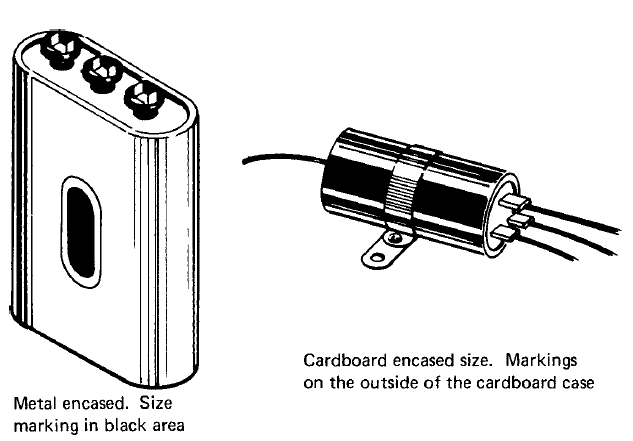TYPES OF CAPACITORS
The capacitor is used in many electric circuits in both electronics and in air conditioning and refrigeration circuits. Two types of capacitors are used in these circuits: fixed and variable.
FIXED CAPACITORS
The fixed capacitor is made for a certain value and is not adjustable. The fixed capacitor is divided into several groupings. It may be made with paper separating two plates of aluminum foil, or it may use plastic, mica, ceramic, or electrolytes.
Most paper capacitors have been replaced by those made of better materials, usually plastic. A typical capacitor is shown in Figure 1. Capacitors are large enough to have their values printed on them. The smaller capacitors use a color code to indicate their value and working voltage. Capacitors come in hundreds of sizes and shapes. It takes a good half-hour to thumb through an electronics catalog that shows all the various types. Each type has a special or particular application. Mica types, for instance, are used for some high-frequency applications with high voltages. The ceramic type is found in circuits that use high voltages, such as television sets and radar equipment.

Figure 1 Fixed capacitors.
ELECTROLYTIC CAPACITORS
The electrolytic capacitor has a very high capacitance value when compared with the types mentioned previously. These capacitors may be tubular or square in shape. They have cardboard or metal covers. Values are printed on the cardboard cover and stamped into the metal cover (see Figure 2). They are available in a variety of shapes and sizes. One characteristic of the electrolytic capacitor is its polarity. Its terminals will have – (negative) or + (positive) marked on them. This means that the circuit power must be connected correctly to avoid damage to the electrolytic capacitor. It is not to be used on ac unless it is an AC electrolytic capacitor and so identified.

Figure 2 Electrolytic capacitor with value marked on it.
Caution: If an electrolytic capacitor marked with a -ve and a +ve is connected to ac, it will explode, and can throw its contents over an area as large as 50 square feet. Thus it can be dangerous. Some are manufactured with a small holes in them so that their contents will spew out instead of exploding. However, safety dictates that you treat all electrolytic capacitors as firecrackers and a larger one as a piece of dynamite. This is another reason for wearing eye protection when working with electric circuits.
Note that the symbols for capacitors in Figure 3 indicate the electrolytic capacitor with polarity markings.

Figure 3 Capacitor symbols with electrical polarity marked.
Electrolytic capacitors are 1 micro farad (uf) and larger in size. They can be made to operate on ac by connecting two of them back-to-back as shown in Figure 4. AC electrolytic capacitors are used in electrical motors, crossover networks in speaker systems, and other places needing large capacitances in circuits that contain ac.

FIGURE 4 Back-to-back electrolytic for ac operation.
VARIABLE CAPACITORS
Variable capacitors are used for tuning purposes in radios and televisions. In most instances, you will not need them for air-conditioning and refrigeration circuits. However, in case you do see one utilized in the electronics control unit, you can identify it by using Figure 5.

Related Topic – click here
- What Is A Diode? Working Principle & Types | Different Types Of Resistors
- What Is Synchronous Speed? | Types & Advantages Of DC Motors
- Working Principle Of Linear Variable Differential Transformer | Construction & Piezoelectric Transducers
- Three-Phase Induction Motor | 3-Phase Induction Motor Principle
- Introduction To Electrical Transformer | Definition, Construction & Parts Of A Transformer | Types Of Transformers
- DC Generator | Principle Of Operation, Construction, Types Of Generators & Application
- What Is DC Motor? | Principle Of DC Motor & Types Of DC Motors
- Diode-Circuits |Diode Convention, Transformer Rectifier & Objective Questions With Answer



